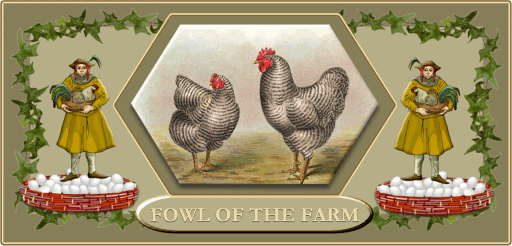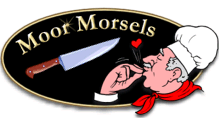
At one time nearly every farm and cott on Dartmoor kept hens, albeit a couple or a couple hundred, where their eggs and meat put food on the table and in some cases coin in the purse. About 40 years ago the normal Sunday roast was either beef or lamb and only on special occasions did a chicken grace the table and that was usually at Easter. How things change, today the cheapest meat is chicken with beef and lamb easily being more expensive.
In most cases the household poultry would be kept to supply the table with meat and the kitchen with eggs. Some of the larger farms would sell their produce at markets or to local butchers and grocers. In 1796, Marshall, p.272, notes the following:
“The only circumstance that struck me, in Devonshire, with respect to this petty article of livestock (poultry), was the scarcity of Eggs, compared with the number of fowls. The markets of Plymouth, I understand are supplied with eggs, in some considerable part from the North of Devonshire; from whence they are sent, twenty or thirty miles, by land; and this while, to common appearance, there are a sufficient number of fowls kept, within then miles of it, to supply all its wants of this article“.
The reason for this was, according to Marshall, the very fact that the birds were kept out in the open and often roosted in trees or shed, the colder temperatures therefore did not induce them to lay eggs. In comparison, he noticed that in areas where the birds were kept inside, in some cases in the actual houses, the birds layed more eggs?
On Dartmoor there were basically two sorts of fowl found in the farmyard; the ‘dunghill cock’ and the ‘barn door fowl’. Cecil Torr records how his grandfather in 1852 noted the following:
“The old barn door or dunghill cock appears to be extinct, being crossed with China, Minorca, etc. I well remember when a boy you could not go out, particularly up the Vale of Lustleigh, but you heard them all crowing in all directions, each on his own dung-hill, challenging each other, and their shrill clarion-like sound echoed through the valley“.
On Dartmoor, the cocks would be known as ‘stags’ or ‘master’ both words alluding to a large, powerful bird. Various breeds have been used on Dartmoor but the more commoner ones were Plymouth Rock, Light Sussex, Barnevelder, Minorca, Wyandotte, and Orpington. These birds, as Marshall observed were generally kept outside and would roost in the trees at night. Occasionally a specialist henhouse would be provided for them to roost in and sometimes they would be allowed to roost over the pig pen (it was thought that foxes were afraid of pigs and so the birds would be safer). The problem with giving the hens the free range of the farm was that they would lay their eggs almost anywhere. Therefore a major task for the farmer’s wife and/or children would be to go out and find the nesting places and gather the eggs. For those that were selling the eggs, it seemed to be the trend to supply brown or tinted eggs as these would fetch between two and three pence a dozen more than the white ones. The Barnevelder were renown for laying brown shelled eggs and the Light Sussex for laying tinted shelled eggs, hence their popularity on the moor.
The hens would provide fresh eggs throughout the laying season and meat for the table on special occasions. Once the birds had been killed they would be plucked and the feathers used for stuffing pillowcases, it was not unheard of to give such a home-made present as a wedding gift. Many households would also pickle eggs in vinegar or spiced vinegar for use in the winter months, these eggs were normally kept in large earthenware jars in the pantry. Another use of the farmyard fowl in some extreme cases was to drop them down the chimney in order to sweep away the soot. As they descended down they would flap their wings in an effort to fly which would brush away all the soot.
Cock fighting was also a popular sport on Dartmoor and many of the cocks would be bred for this purpose. Hemery, 1987, p.530 notes how at Sherwell there used to be an inn called ‘The Cocklers’ Peep’ ( a cockler was someone who bred cocks) where cockfights were often held, indeed, it is related how Joe Leaman lost his prize cock to the landlord’s one day.
As with any beast that lives upon the moor there is a whole wealth of tradition and superstition attached to the farmyard fowl, especially centred on the cock. For instance, it was always deemed a harbinger of death or misfortune to hear a cock crow at midnight. To hear a cock crowing at ones door would mean that a visitor or news was coming from afar. If the cock crows whilst it is raining then this is a sure sign that there will be good weather for the rest of the day.
To bring a small bunch of primroses into a poultry farmers house was considered to be unlucky. This was because the number of chickens reared that year would correspond to the number of primroses brought into the house, so it was always best to pick a huge bunch of them.
There is an old adage which goes; “Every cock will crow on its own dunghill“, which basically means everyone is at ease or comfortable on their home ground.

As with most beasts of the moor, farmyard fowl have been the main ingredient for many traditional Dartmoor recipes. To this end the famous Dartmoor chef, Dean Burn, has come up with a mouth-watering chicken dish:
FOWL POT PIE
Ingredients:
2 – large chicken breast
4 – slices streaky bacon
1 – large onion
4 – medium sized carrots
½ – pint of dry cider
Suet Crust Pastry
2 – ounces butter
Methodology.
Slice the chicken breasts into thickish strips.
Melt the butter in a pan and fry the chicken breasts until golden brown on all sides.
Slice the onion into half rings and fry until see through.
Slice the carrots
Chop the bacon into lardons.
Go out into the shed and find a large flowerpot, preferably one that has no insect life living in it or one that the cat hasn’t urinated in.
Place the chicken, bacon, onion, carrots and cider in the pot and cover with a suet crust pastry lid.
Place in a preheated oven (375 or gas mark 5) for 1½ hours.
Once cooked deliver to the table and serve straight from the flower pot along with mashed potato and garden peas. This is also an ideal opportunity to drink the remaining 7½ pints of cider. Oh, I do apologise, if at this point your tablecloth is saturated with cider stock then feel free to blame me. I have just realised that I forgot to mention that you must ensure the flowerpot hasn’t got a drainage hole in the bottom.
 Legendary Dartmoor The many aspects past and present of Dartmoor
Legendary Dartmoor The many aspects past and present of Dartmoor
